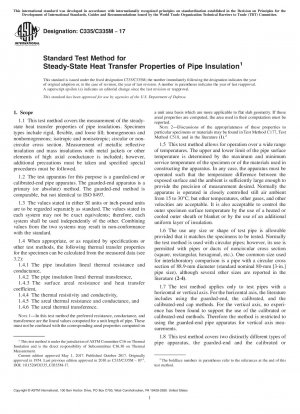ASTM C335/C335M-17
Standard Test Method for Steady-State Heat Transfer Properties of Pipe Insulation
- Standard No.
- ASTM C335/C335M-17
- Release Date
- 2017
- Published By
- American Society for Testing and Materials (ASTM)
- Status
- Replace By
- ASTM C335/C335M-23
- Latest
- ASTM C335/C335M-23
- Scope
-
4.1 As determined by this test method, the pipe insulation lineal thermal resistance or conductance (and, when applicable, the thermal resistivity or conductivity) are means of comparing insulations which include the effects of the insulation and its fit upon the pipe, circumferential and longitudinal jointing, and variations in construction, but do not include the effects of the outer surface resistance or heat transfer coefficient. They are thus appropriate when the insulation outer-surface temperature and the pipe temperature are known or specified. However, since the thermal properties determined by this test method include the effects of fit and jointing, they are not true material properties. Therefore, properties determined by this test method are somewhat different from those obtained on apparently similar material in flat form using the guarded hot plate, Test Method C177, or the heat flow meter apparatus, Test Method C518.
4.2 The pipe insulation lineal thermal transference incorporates both the effect of the insulation and its fit upon the pipe and also the effect of the surface heat-transfer coefficient. It is appropriate when the ambient conditions and the pipe temperature are known or specified and the thermal effects of the surface are to be included.
4.3 Because of the test condition requirements prescribed in this test method, recognize that the thermal transfer properties obtained will not necessarily be the value pertaining under all service conditions. As an example, this test method provides that the thermal properties shall be obtained by tests on dry or conditioned specimens, while such conditions are not necessarily realized in service. The results obtained are strictly applicable only for the conditions of test and for the product construction tested, and must not be applied without proper adjustment when the material is used at other conditions, such as mean temperatures that differ appreciably from those of the test. With these qualifications in mind, the following apply:
4.3.1 For horizontal or vertical pipes of the same size and temperature, operating in the same ambient environment, values obtained by this test method can be used for the direct comparison of several specimens, for comparison to specification values, and for engineering data for estimating heat loss of actual applications of specimens identical to those tested (including any jackets or surface treatments). When appropriate, correct for the effect of end joints and other recurring irregularities (4.4).
4.3.2 When applying the results to insulation sizes different from those used in the test, an appropriate mathematical analysis is required. For homogeneous materials, this consists of the use of the thermal conductivity or resistivity values (corrected for any changes in mean temperature) plus the use of the surface heat transfer coefficient when the ambient temperature is considered (for example, see Practice C680). For nonhomogeneous and reflective insulation materials, a more detailed mathematical model is required which properly accounts for the individual modes of heat transfer (conduction, convection, radiation) and the variation of each mode with changing pipe size, insulation thickness, and temperature.
ASTM C335/C335M-17 Referenced Document
- ASTM C1045 Standard Practice for Calculating Thermal Transmission Properties Under Steady-State Conditions
- ASTM C1058 Standard Practice for Selecting Temperatures for Evaluating and Reporting Thermal Properties of Thermal Insulation
- ASTM C168 Standard Terminology Relating to Thermal Insulation
- ASTM C177 Standard Test Method for Steady-State Heat Flux Measurements and Thermal Transmission Properties by Means of the Guarded-Hot-Plate Apparatus
- ASTM C302 Standard Test Method for Density and Dimensions of Preformed Pipe-Covering-Type Thermal Insulation
- ASTM C518 Standard Test Method for Steady-State Thermal Transmission Properties by Means of the Heat Flow Meter Apparatus
- ASTM C680 Standard Practice for Determination of Heat Gain or Loss and the Surface Temperatures of Insulated Pipe and Equipment Systems by the Use of a Computer Program
- ASTM C870 Standard Practice for Conditioning of Thermal Insulating Materials
- ASTM E230 Standard Specification and Temperature-Electromotive Force (EMF) Tables for Standardized Thermocouples
- ISO 8497 Thermal insulation; determination of steady-state thermal transmission properties of thermal insulation for circular pipes
ASTM C335/C335M-17 history
- 2023 ASTM C335/C335M-23 Standard Test Method for Steady-State Heat Transfer Properties of Pipe Insulation
- 2017 ASTM C335/C335M-17 Standard Test Method for Steady-State Heat Transfer Properties of Pipe Insulation
- 2010 ASTM C335/C335M-10e1 Standard Test Method for Steady-State Heat Transfer Properties of Pipe Insulation
- 2010 ASTM C335/C335M-10 Standard Test Method for Steady-State Heat Transfer Properties of Pipe Insulation
- 2005 ASTM C335-05ae1 Standard Test Method for Steady-State Heat Transfer Properties of Pipe Insulation
- 2005 ASTM C335-05a Standard Test Method for Steady-State Heat Transfer Properties of Pipe Insulation
- 2005 ASTM C335-05 Standard Test Method for Steady-State Heat Transfer Properties of Pipe Insulation
- 2003 ASTM C335-03a Standard Test Method for Steady-State Heat Transfer Properties of Horizontal Pipe Insulation
- 1995 ASTM C335-95 Standard Test Method for Steady-State Heat Transfer Properties of Horizontal Pipe Insulation

Copyright ©2024 All Rights Reserved